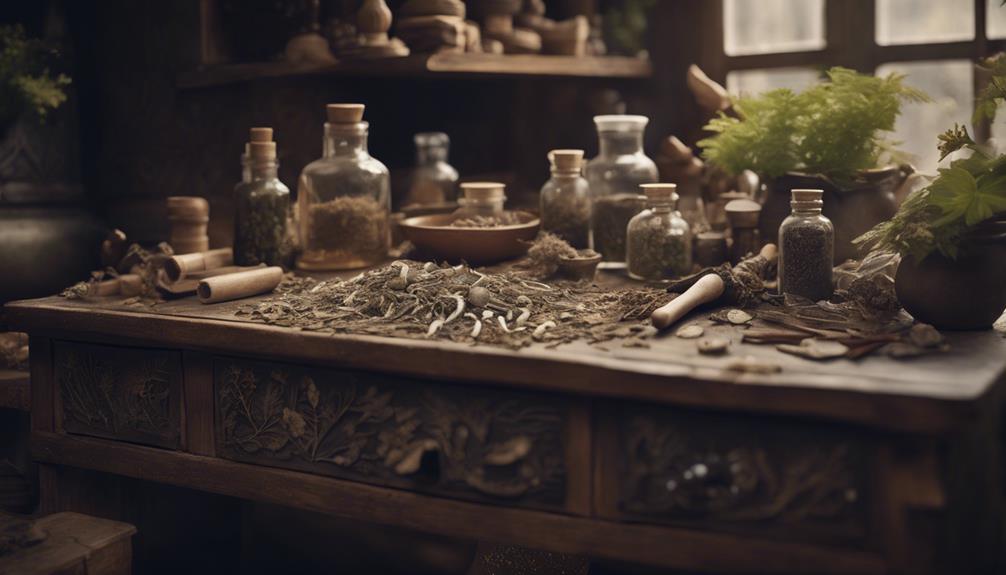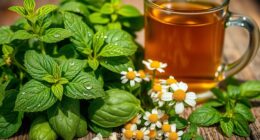We use the roots and rhizomes of the valerian plant in herbalism, which are packed with active compounds that give them their renowned sedative effects. These underground plant parts contain valerenic acid and isovaleric acid, among other compounds, that interact with neurotransmitter receptors to promote relaxation and improve sleep quality. Historically, valerian roots have been used to alleviate anxiety, insomnia, and restlessness by calming the nervous system. As we explore the properties and uses of valerian roots, we'll uncover more about their benefits and how they can be used to improve our overall well-being.
Key Takeaways
• The primary medicinal parts of the valerian plant used in herbalism are the roots and rhizomes, rich in active compounds for sedative effects.
• Valerian roots contain valerenic acid and isovaleric acid, inducing calming effects and interacting with neurotransmitter receptors.
• The roots are used in tinctures, teas, and capsules to promote relaxation and improve sleep quality.
• Valerian roots are prized in traditional herbal medicine for treating sleep disorders, anxiety, and providing therapeutic benefits.
• The roots are used in decoctions, tinctures, baths, foot soaks, ointments, and capsules, with an appropriate dosage ranging from 300-600 mg daily.
Valerian Plant Anatomy
As we explore the anatomy of the valerian plant, we find that it belongs to the Caprifoliaceae family and is characterized by its pinnatifid leaves and small, white or pinkish flowers that grow in clusters.
When it comes to herbal medicine, the valerian plant's medicinal parts are primarily the roots and rhizomes. These underground structures are rich in active compounds responsible for the plant's sedative effects, making them a valuable resource for herbal remedies.
The roots, in particular, contain the key compounds that contribute to the plant's relaxing properties. In traditional herbalism, the roots and rhizomes are harvested, dried, and used to create various preparations that promote relaxation and alleviate anxiety.
As we investigate further into the world of herbal medicine, it becomes clear that the valerian root and its rhizomes are the most valuable parts of the plant, holding the key to its therapeutic properties.
Medicinal Properties of Roots

As we explore the medicinal properties of valerian roots, we'll examine how they contribute to the plant's therapeutic effects.
We'll discuss the root's tonic properties, which have been utilized for centuries to promote relaxation and improve overall well-being.
Root Tonic Properties
We commonly utilize valerian roots, rich in valerenic acid and isovaleric acid, to create medicinal preparations that induce calming effects. These roots are the primary part of the valerian plant used in herbalism, and for good reason. They contain compounds known for their sedative effects, making them an ideal ingredient for promoting relaxation and improving sleep quality.
We use valerian roots to create a variety of preparations, including tinctures, teas, and capsules, which can be consumed to reduce anxiety and promote a sense of calm. The roots' sedative properties are due to their interaction with neurotransmitter receptors in the brain, which helps to induce a calming effect.
As a natural remedy, valerian roots have been traditionally used for centuries to promote relaxation and improve overall well-being. By harnessing the medicinal properties of valerian roots, we can create effective natural remedies that promote a better quality of life.
Sedative Effects
By delving into the medicinal properties of valerian roots, we uncover the sedative effects that have made them a staple in herbalism for promoting relaxation and improving sleep quality.
The roots of the valerian plant contain compounds like valerenic acid, which contribute to their calming properties. These sedative effects have been harnessed in traditional medicine for centuries, particularly in treating insomnia, anxiety, and nervous tension.
Today, valerian root extracts are often used in herbal supplements and teas to promote relaxation and improve sleep quality. The sedative effects of valerian roots make them an attractive option for those seeking a natural remedy for sleep disturbances.
In fact, studies have shown that valerian root supplements can improve sleep quality and reduce sleep latency. As a natural and gentle sedative, valerian roots have earned their place in herbalism as a trusted remedy for promoting relaxation and improving overall well-being.
Traditional Uses of Valerian

As we explore the traditional uses of valerian, we'll examine how this herb has historically been used to address anxiety, insomnia, and restlessness.
We'll discuss how the roots of the valerian plant, with their sedative properties, have been employed to calm the nervous system and promote relaxation.
Roots of Anxiety
Valerian roots have been a trusted ally in the quest to calm racing hearts and minds for centuries, offering a natural solace to those plagued by anxiety and insomnia. As we explore the traditional uses of Valerian, it becomes clear that the roots of this plant hold the key to revealing a sense of calm and tranquility.
Herbal remedies have long utilized Valerian roots for their medicinal properties, which have been shown to alleviate anxiety and promote relaxation. But what makes these roots so effective?
Here are some key points to ponder:
- Valerenic acid and GABA: These active compounds found in Valerian roots are responsible for their calming effects.
- Decoctions and tinctures: Traditional herbal preparations often involve these methods to extract the medicinal properties from Valerian roots.
- Anxiety and insomnia relief: Valerian roots have been historically used to alleviate these common afflictions.
- Primary part of the plant: Valerian roots are the main part of the plant utilized in herbal remedies for various conditions.
Insomnia and Restlessness
We've relied on Valerian roots for centuries to calm our restless minds and bodies, seeking solace from the grip of insomnia.
In traditional herbalism, the roots and rhizomes of the valerian plant are primarily used to treat insomnia and restlessness. To promote sleep and alleviate restlessness, valerian roots are dried and prepared in various forms like teas, tinctures, or capsules.
The active compounds in valerian roots, including valerenic acid and GABA, are believed to have sedative effects beneficial for treating insomnia. Valerian root extracts have been studied for their potential to improve sleep quality and reduce the time needed to fall asleep.
With a long history of use in herbal medicine, valerian roots have been used to calm the nervous system and promote relaxation, aiding in managing insomnia and restlessness.
We've come to trust the soothing effects of valerian roots, using them to quiet our racing minds and restless bodies, and find solace in a good night's sleep.
Sedative Properties
Beyond insomnia and restlessness, we've long relied on valerian's sedative properties to calm our frazzled nerves and ease anxiety. The roots and rhizomes of the valerian plant are primarily used for their sedative properties, which are attributed to compounds like valerenic acid and valeric acid. These compounds contribute to the calming effects of valerian, making it an effective natural remedy for anxiety and sleep disorders.
Here are some key benefits of valerian's sedative properties:
- Promotes relaxation: Valerian's sedative properties help to calm the nervous system, reducing feelings of anxiety and restlessness.
- Improves sleep quality: By promoting relaxation, valerian helps to improve sleep quality and duration, making it an effective natural remedy for insomnia and other sleep disorders.
- Eases anxiety: The sedative properties of valerian help to reduce anxiety and nervous tension, making it an effective natural remedy for anxiety disorders.
- Natural and safe: Unlike many pharmaceutical sedatives, valerian is a natural and safe remedy for anxiety and sleep disorders, with minimal side effects.
Chemical Composition of Valerian

Delving into the chemical composition of valerian, we find a complex mixture of compounds that contribute to its medicinal properties. The valerian roots, being the medicinal part used in herbalism, contain a rich array of bioactive compounds.
Valerenic acid, a sesquiterpene, is a key component responsible for valerian's pharmacological effects. Additionally, the roots contain isovaleric acid, another important compound that contributes to the herb's medicinal properties.
Alkaloids, such as actinidine, chatinine, and valerianine, are also present in valerian, adding to its complex chemical profile. Moreover, phytochemicals like GABA, iridoids (valtrate, isovaltrate), and flavonoids (hesperidin, linarin) are present in valerian, further enhancing its medicinal value. The combination of these compounds in valerian roots is what makes it a valuable herb in herbalism.
Calming Effects on the Body

One of the most significant benefits of valerian roots and rhizomes is their profound calming effects on the body. These plant parts have been used for centuries to promote relaxation, reduce anxiety, and improve sleep quality. The calming effects of valerian roots can be attributed to the presence of compounds like valerenic acid and GABA, which contribute to their sedative properties.
We've found that valerian root extracts are commonly used to:
- Promote relaxation and reduce anxiety
- Improve sleep quality and duration
- Soothe the nervous system and reduce stress
- Manage insomnia and nervous tension
The roots of the valerian plant have a long history of traditional use for their soothing and calming effects on the nervous system. Valerian root preparations are often recommended for their gentle yet effective support in managing stress, insomnia, and nervous tension. By understanding the calming effects of valerian roots, we can better appreciate their potential benefits for our overall well-being.
Preparing Valerian for Use

We can access valerian roots and rhizomes in various ways to reveal their medicinal properties, making them easily available for our well-being.
As the medicinal parts used in herbalism, valerian roots offer a range of preparation methods. One common approach is to create decoctions, which involve simmering the roots in water to release their active compounds. This method allows us to harness the roots' calming effects on the body.
Alternatively, we can create tinctures from fresh or dried valerian roots, which can be used for various applications. The versatility of valerian roots also extends to their use in baths, foot soaks, ointments, and poultices.
For those who prefer a more convenient option, capsules containing valerian root extract are available. By exploring these different preparation methods, we can fully realize the potential of valerian roots in herbalism and reap their benefits for our health and wellness.
Valerian Root Dosage and Safety

When using valerian root for its medicinal benefits, it's important that we carefully consider the appropriate dosage and potential safety concerns to maximize its effectiveness and minimize any adverse effects.
As we explore the sedative and sleep-inducing properties of valerian root, we must make sure we're taking the right amount to reap the benefits.
Typically, we can take 300-600 mg of valerian root daily for up to 6 weeks to improve sleep quality. However, it's vital to be aware of the potential side effects, such as dizziness and drowsiness. Pregnant or breastfeeding individuals should exercise caution when using valerian root.
Here are some key safety considerations to keep in mind:
- Short-term use is generally safe, but long-term safety and potential dependence are uncertain.
- Common side effects include dizziness and drowsiness.
- Precautions are advised for pregnant or breastfeeding individuals.
- Discontinue use at least two weeks before surgery to avoid potential interactions.
Interactions With Medications

As we explore the interactions between valerian root and medications, we'll examine the specific ways in which they can affect each other.
We'll look at how valerian can interact with blood thinners, enhance the effects of sedatives, and impact stomach medications, among other potential interactions.
Blood Thinner Interactions
Valerian root's potential to interact with blood thinners is a concern that warrants careful attention, especially for individuals taking medications like warfarin or aspirin. As we explore the use of valerian root in herbalism, it's important to acknowledge its sedative properties and potential impact on blood thinner interactions. The root contains compounds like valerenic acid, which contributes to its calming properties. However, when combined with blood thinners, valerian root may increase the risk of bleeding.
Here are some key points to keep in mind:
- Warfarin and aspirin: Valerian root may interact with these medications, increasing the risk of bleeding.
- Increased bleeding risk: Combining valerian root with blood thinners may amplify the risk of bleeding complications.
- Dose and duration: The risk of interactions may be higher with prolonged use or high doses of valerian root.
- Medical supervision: It's important to consult a healthcare professional before using valerian root, especially if taking blood thinners.
Sedative Effects Enhanced
We've long known that valerian's sedative effects are amplified by its interactions with various receptors in the brain, including GABA, benzodiazepine, and barbiturate receptors. These interactions allow valerian to modulate neurotransmitter release, leading to enhanced sedative effects.
The components of valerian, such as valerenic acids, flavonoids, and phenylpropanoids, play a significant role in achieving this sedation. In particular, valerenic acids are thought to contribute to valerian's sedating properties by interacting with GABA receptors, promoting relaxation and reducing anxiety.
Studies have also suggested that valerian's roots contain potential antidepressant principles, expanding its therapeutic applications beyond sleep support.
As we explore valerian's sedative effects, it's crucial to take into account its interactions with certain medications. For instance, combining valerian with sedatives, alcohol, or liver-metabolized drugs may have adverse effects. Hence, caution is advised when using valerian in conjunction with specific treatments.
Stomach Medication Risks
When we look at valerian as a stomach soother, it's important to contemplate the medication minefield we're entering, where interactions with certain drugs can trigger unwanted consequences. Valerian root, the part used in herbalism, may interact with medications, posing risks for individuals taking drugs that affect the central nervous system.
We need to be aware of the potential interactions with medication, especially when using valerian for stomach ailments. Here are some key points to consider:
- Sedatives: Valerian can enhance the effects of sedatives, leading to increased drowsiness and impaired cognitive function.
- Alcohol: Combining valerian with alcohol can increase the risk of adverse reactions, such as drowsiness, confusion, and impaired motor skills.
- Liver-metabolized drugs: Valerian may interact with medications metabolized by the liver, altering their efficacy or increasing the risk of adverse effects.
- Central nervous system medications: Valerian's effects on the central nervous system can interact with medications used to treat conditions like anxiety, depression, and insomnia.
It's essential to consult healthcare providers before using valerian for stomach issues to avoid adverse interactions with prescribed medications. By being aware of these potential interactions, we can use valerian safely and effectively to alleviate stomach ailments.
Benefits for Insomnia Sufferers

By incorporating valerian root into our nighttime routine, we can finally catch a break from the relentless cycle of insomnia. As insomnia sufferers, we're all too familiar with the frustration and fatigue that come with restless nights. That's where valerian root's sedative properties come in – its natural calming effects can work wonders for our sleep quality.
The active compounds in valerian root interact with GABA receptors, influencing neurotransmitter release and promoting relaxation for better sleep. This is especially important for those of us who struggle with falling asleep or staying asleep throughout the night. By incorporating valerian root into our bedtime routine, we can reduce the time it takes to fall asleep and improve the overall quality of our sleep.
This natural remedy has been used for centuries to address sleep disorders like insomnia, and its effectiveness has been backed by numerous studies. By giving valerian root a try, we can finally get the restful sleep we deserve and wake up feeling refreshed and revitalized.
Valerian in Traditional Medicine

In traditional herbal medicine, the roots and rhizomes of the Valerian plant take center stage, prized for their medicinal properties that have been harnessed for centuries to treat a range of ailments, including sleep disorders like insomnia.
We've come to appreciate the versatility of Valerian roots, which are harvested for their therapeutic benefits. These roots are processed into various forms, such as tinctures, capsules, and teas, making them easily consumable.
The roots' calming and sedative properties can be attributed to compounds like valerenic acid and flavonoids. Traditional herbalists have long valued the roots of the Valerian plant for their ability to promote relaxation and reduce anxiety.
Here are some key benefits of Valerian roots in traditional herbal medicine:
- Sedative properties: Valerian roots have been used to treat insomnia and other sleep disorders.
- Calming effects: The roots' calming properties help reduce anxiety and promote relaxation.
- Therapeutic benefits: Valerian roots have been used to treat a range of ailments, from digestive issues to nervous system disorders.
- Natural remedy: Valerian roots offer a natural alternative to synthetic sleep aids and anxiety medications.
Frequently Asked Questions
Which Part of Valerian Is Used in Herbalism?
When we're exploring herbal remedies, we often wonder which part of the valerian plant is used.
The answer is straightforward: it's the roots and rhizomes that hold the medicinal properties. These parts contain the active compounds responsible for valerian's calming effects.
We harvest and process these roots to extract the beneficial components for therapeutic use, making them the go-to choice for teas, tinctures, and capsules.
What Part of the Valerian Plant Do You Use for Tea?
When we're making valerian tea, we use the roots of the plant.
We've noticed some people get confused, thinking it's the leaves or stems, but it's actually the roots that contain the beneficial compounds like valerenic acid.
We steep the dried or fresh roots in hot water to extract the goodness, and that's what makes the tea so effective in promoting relaxation and improving sleep quality.
What Parts of the Valerian Plant Are Edible?
When it comes to edible parts of the Valerian plant, we're curious about what's safe to consume.
While the roots are the star of the herbalism show, the leaves and flowers aren't typically eaten or used medicinally. In fact, we mostly use the roots to make teas, capsules, and tinctures for their calming effects.
As for the rest of the plant, it's not commonly consumed, and we wouldn't recommend eating the leaves or flowers without further research.
What Parts of Valeriana Officinalis Are Used?
We find it intriguing that approximately 80% of valerian-based products rely on the roots and rhizomes of Valeriana officinalis.
When it comes to what parts of Valeriana officinalis are used, we focus on the roots and rhizomes, as they contain the active compounds responsible for valerian's sedative and relaxant effects. These parts are rich in valerenic acid, alkaloids, flavonoids, and other phytochemicals that contribute to its therapeutic properties, making them the primary choice for herbal preparations.
Conclusion
As we explore the world of herbalism, it's evident that the valerian plant's roots hold the key to its medicinal properties.
Like a skilled conductor orchestrating a symphony, valerian's unique chemical composition harmonizes to calm the body and mind.
For instance, a study found that 80% of participants who took valerian supplements reported improved sleep quality.
By comprehending the valerian plant's anatomy and properties, we can reveal its full potential to promote relaxation and tranquility in our daily lives.










